Cubes and Dice Important Questions - Page 2
Cubes and Dice Video Lecture - Page 3
In problems involving cubes and dice, we are required to analyse the situation in respect of the following aspects.
- Counting the number of cubes in a figure.
- Counting the number of painted faces of cubes formed by cutting a solid cube or cuboid in a specific manner.
- Construction of the cubical boxes.
- Analysing the positions of a dice.
Point wise analysis of these aspects is to be the subject matter of this chapter.
Counting the number of cubes in a figure
Example 1: Count the number of cubes in the following figure.
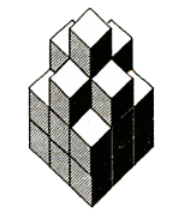
Solution: Clearly, we have four columns containing one cube each, three columns containing two cubes each two columns containing three cubes each. Thus, the total number of cubes
= ( 4 × 1 ) + ( 3 × 2 ) + ( 2 × 3 ) = 4+6+6 = 16.
Example 2: Count the number of cubes in the following figure.
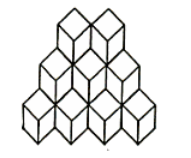
Solution: Here, we have 4 columns containing 2 cubes each, 4 columns containing 3 cubes each and 1 column containing 4 cubes. Thus, the total number of cubes
= ( 4 × 2 ) + ( 4 × 3 ) + ( 1 × 4 ) = 8+12+4 = 24
Cubes and Dice Questions from Previous Year Exams
Quiz-summary
0 of 30 questions completed
Questions:
- 1
- 2
- 3
- 4
- 5
- 6
- 7
- 8
- 9
- 10
- 11
- 12
- 13
- 14
- 15
- 16
- 17
- 18
- 19
- 20
- 21
- 22
- 23
- 24
- 25
- 26
- 27
- 28
- 29
- 30
Information
- Cubes and Dice
You have already completed the quiz before. Hence you can not start it again.
Quiz is loading...
You must sign in or sign up to start the quiz.
You have to finish following quiz, to start this quiz:
Results
0 of 30 questions answered correctly
Your time:
Time has elapsed
You have reached 0 of 0 points, (0)
| Average score |
|
| Your score |
|
Categories
- Not categorized 0%
- 1
- 2
- 3
- 4
- 5
- 6
- 7
- 8
- 9
- 10
- 11
- 12
- 13
- 14
- 15
- 16
- 17
- 18
- 19
- 20
- 21
- 22
- 23
- 24
- 25
- 26
- 27
- 28
- 29
- 30
- Answered
- Review
-
Question 1 of 30
1. Question
1 pointsThe sheet of paper shown in the figure (X) given on the left hand side, in each problem, is folded to form a box. Choose from amongst the alternatives (1), (2), (3) and (4), the boxes that are similar to the box that will be formed.
Choose the box that is similar to the box formed from the given sheet of paper (X).
 Correct
Correct
The fig. (X) is similar to Form V. So, when the sheet shown in fig. (X) is folded to form a cube, then the face with shading lies opposite to the free bearing a square, the face bearing a dot lies opposite to a blank face and the face bearing a circle (with a '+' sign inside it) lies opposite to another blank face. The cubes in figures (2) and (4) have the shaded face adjacent to the face bearing a square. Therefore, the cubes in these two figures cannot be formed. Hence, only cubes in figures (1) and (3) can be formed.
Incorrect
The fig. (X) is similar to Form V. So, when the sheet shown in fig. (X) is folded to form a cube, then the face with shading lies opposite to the free bearing a square, the face bearing a dot lies opposite to a blank face and the face bearing a circle (with a '+' sign inside it) lies opposite to another blank face. The cubes in figures (2) and (4) have the shaded face adjacent to the face bearing a square. Therefore, the cubes in these two figures cannot be formed. Hence, only cubes in figures (1) and (3) can be formed.
-
Question 2 of 30
2. Question
1 pointsWhich of the following finished patterns can be obtained from the piece of cardboard (X) shown below?
 Correct
Correct
The pattern on fig. (X) and also the fact that the faces are rectangle, indicate that only fig. (1) can be obtained by folding fig. (X).
Incorrect
The pattern on fig. (X) and also the fact that the faces are rectangle, indicate that only fig. (1) can be obtained by folding fig. (X).
-
Question 3 of 30
3. Question
1 pointsChoose the box that is similar to the box formed from the given sheet of paper (X).
 Correct
Correct
The fig. (X) is similar to Form I. So, when the sheet shown in fig. (X) is folded to form a box (cuboid), then the two rectangular-shaded faces lie opposite to each other, two rectangular white faces lie opposite to each other and the two square shaped faces (one shaded and one white) lie opposite to each other. Clearly, the cuboids shown in figures (2) and (4) cannot be formed as in each of the two cuboids the two shaded rectangular faces appear adjacent to each other. So, only the cuboids in figures (1) and (3) can be formed.
Incorrect
The fig. (X) is similar to Form I. So, when the sheet shown in fig. (X) is folded to form a box (cuboid), then the two rectangular-shaded faces lie opposite to each other, two rectangular white faces lie opposite to each other and the two square shaped faces (one shaded and one white) lie opposite to each other. Clearly, the cuboids shown in figures (2) and (4) cannot be formed as in each of the two cuboids the two shaded rectangular faces appear adjacent to each other. So, only the cuboids in figures (1) and (3) can be formed.
-
Question 4 of 30
4. Question
1 pointsChoose the box that is similar to the box formed from the given sheet of paper (X).
 Correct
Correct
The fig. (X) is similar to the Form VII. So, when a cube is formed by folding the sheet shown in fig. (X), then is one of the faces of the cube and this face lies opposite to a blank face. Also, a face bearing a square lies opposite to another blank face. The remaining two blank faces lie opposite to each other. Clearly, in the cube shown in fig. (1), the face consisting of the four symbols is not the same as that formed (as shown above). Hence, the cube in fig. (1) cannot be formed.
Incorrect
-
Question 5 of 30
5. Question
1 pointsChoose the box that is similar to the box formed from the given sheet of paper (X).
 Correct
Correct
The fig. (X) is similar to the Form VI. So, when a cube is formed by folding the sheet shown in fig. (X), then is one of the faces of the cube and this face lies opposite to a blank face. Also, a face bearing a circle lies opposite to one bearing a dot. Clearly, this cube does not have faces as shown in the cubes in figures (3) and (4). Hence, only the cubes shown in figures (1) and (2) can be formed.
Incorrect
The fig. (X) is similar to the Form VI. So, when a cube is formed by folding the sheet shown in fig. (X), then is one of the faces of the cube and this face lies opposite to a blank face. Also, a face bearing a circle lies opposite to one bearing a dot. Clearly, this cube does not have faces as shown in the cubes in figures (3) and (4). Hence, only the cubes shown in figures (1) and (2) can be formed.
-
Question 6 of 30
6. Question
1 pointsChoose the box that is similar to the box formed from the given sheet of paper (X).
 Correct
Correct
The fig. (X) is similar to the Form I. So, when the sheet in fig. (X) is folded to form a cube, then the completely shaded face lies opposite to the half shaded face. Therefore, the cubes shown in figures (1) and (3) which have the completely shaded face adjacent to the half-shaded face cannot be formed. Since Fig 4 does't have at-least one shaded face, it cannot be formed. Hence, only the cubes in figure (2) can be formed.
Incorrect
The fig. (X) is similar to the Form I. So, when the sheet in fig. (X) is folded to form a cube, then the completely shaded face lies opposite to the half shaded face. Therefore, the cubes shown in figures (1) and (3) which have the completely shaded face adjacent to the half-shaded face cannot be formed. Since Fig 4 does't have at-least one shaded face, it cannot be formed. Hence, only the cubes in figure (2) can be formed.
-
Question 7 of 30
7. Question
1 pointsChoose the box that is similar to the box formed from the given sheet of paper (X).
 Correct
Correct
The fig. (X) is similar to the Form V. So, when the sheet shown in fig. (X) is folded to form a cube then the shaded face lies opposite to one of the blank faces, the face bearing a circle lies opposite to another blank face and the face bearing a shaded square lies opposite to the third blank face. Thus, each one of the cubes shown in figures (1), (2) and (4) can be formed. Also, though the cube shown in fig. (3) has faces that can appear adjacent to each other but the cube formed by folding the sheet in fig. (X) cannot be rotated to form fig. (3). Hence, the cube in fig.(3) cannot be formed.
Incorrect
The fig. (X) is similar to the Form V. So, when the sheet shown in fig. (X) is folded to form a cube then the shaded face lies opposite to one of the blank faces, the face bearing a circle lies opposite to another blank face and the face bearing a shaded square lies opposite to the third blank face. Thus, each one of the cubes shown in figures (1), (2) and (4) can be formed. Also, though the cube shown in fig. (3) has faces that can appear adjacent to each other but the cube formed by folding the sheet in fig. (X) cannot be rotated to form fig. (3). Hence, the cube in fig.(3) cannot be formed.
-
Question 8 of 30
8. Question
1 pointsChoose the box that is similar to the box formed from the given sheet of paper (X).
 Correct
Correct
The fig. (X) is similar to the Form V. So, when the sheet in fig. (X) is folded to form a cube, then the face bearing a square lies opposite to the face bearing a circle. Therefore, the cubes shown in figures (1) and (2) which have the faces bearing the square and the circle adjacent to each other, cannot be formed. Hence, only the cubes in figures (3) and (4) can be formed.
Incorrect
The fig. (X) is similar to the Form V. So, when the sheet in fig. (X) is folded to form a cube, then the face bearing a square lies opposite to the face bearing a circle. Therefore, the cubes shown in figures (1) and (2) which have the faces bearing the square and the circle adjacent to each other, cannot be formed. Hence, only the cubes in figures (3) and (4) can be formed.
-
Question 9 of 30
9. Question
1 pointsChoose the box that is similar to the box formed from the given sheet of paper (X).
 Correct
Correct
When the sheet in fig. (X) is folded, then one of the faces of the cube formed will be of the form and this face will lie opposite the face bearing a square. Also, one of the blank faces lies opposite another blank face and the third blank face lies opposite the face bearing an '=' sign. Clearly, all the three blank faces cannot appear adjacent to each other. So, the cube shown in fig. (2) which has all the three blank faces adjacent to each other cannot be formed. Hence, only the cubes shown in figures A, C and D can be formed.
Incorrect
When the sheet in fig. (X) is folded, then one of the faces of the cube formed will be of the form and this face will lie opposite the face bearing a square. Also, one of the blank faces lies opposite another blank face and the third blank face lies opposite the face bearing an '=' sign. Clearly, all the three blank faces cannot appear adjacent to each other. So, the cube shown in fig. (2) which has all the three blank faces adjacent to each other cannot be formed. Hence, only the cubes shown in figures A, C and D can be formed.
-
Question 10 of 30
10. Question
1 pointsChoose the box that is similar to the box formed from the given sheet of paper (X).
 Correct
Correct
The fig. (X) is similar to the Form III. So, when the sheet in fig. (X) is folded to form a cube, then 'F' appears opposite 'B', 'E' appears opposite 'C' and 'A' appears opposite 'D' Therefore, the cube in fig. (1) which shows 'F' adjacent to 'B' the cube in fig. (3) which shows 'E' adjacent to 'C' and the cube in fig. (4) which shows 'A' adjacent to 'D' cannot be formed. Hence, only the cube in fig.(2) can be formed.
Incorrect
The fig. (X) is similar to the Form III. So, when the sheet in fig. (X) is folded to form a cube, then 'F' appears opposite 'B', 'E' appears opposite 'C' and 'A' appears opposite 'D' Therefore, the cube in fig. (1) which shows 'F' adjacent to 'B' the cube in fig. (3) which shows 'E' adjacent to 'C' and the cube in fig. (4) which shows 'A' adjacent to 'D' cannot be formed. Hence, only the cube in fig.(2) can be formed.
-
Question 11 of 30
11. Question
1 pointsChoose the box that is similar to the box formed from the given sheet of paper (X).
 Correct
Correct
The fig. (X) is similar to the Form III. So, when the sheet in fig. (X) is folded to form a cube, then the half-shaded face appears opposite to the face bearing a rhombus, the face with a black circle appears opposite to one of the two blank faces and the face with a '+' sign appears opposite to the other blank face. Clearly, the cubes shown in figures (1) and (4) cannot be formed since they have the half-shaded face adjacent to the face bearing the rhombus. Also, though the cube shown in fig. (3) has faces that can appear adjacent to each other but the cube formed by folding the sheet in fig. (X) cannot be rotated to form fig. (3). Hence, the cube in fig. (3) cannot be formed. Thus, only the cube shown in fig. (2) can be formed.
Incorrect
The fig. (X) is similar to the Form III. So, when the sheet in fig. (X) is folded to form a cube, then the half-shaded face appears opposite to the face bearing a rhombus, the face with a black circle appears opposite to one of the two blank faces and the face with a '+' sign appears opposite to the other blank face. Clearly, the cubes shown in figures (1) and (4) cannot be formed since they have the half-shaded face adjacent to the face bearing the rhombus. Also, though the cube shown in fig. (3) has faces that can appear adjacent to each other but the cube formed by folding the sheet in fig. (X) cannot be rotated to form fig. (3). Hence, the cube in fig. (3) cannot be formed. Thus, only the cube shown in fig. (2) can be formed.
-
Question 12 of 30
12. Question
1 pointsChoose the box that is similar to the box formed from the given sheet of paper (X).
 Correct
Correct
The fig. (X) is similar to the Form II. So, when the sheet shown in fig. (X) is folded to form a cube then the two half-shaded faces lie opposite to each other, the face bearing a square lies opposite to one of the two blank faces and the face bearing a circle lies opposite to the other blank face. Therefore, the cubes shown in figures (2) and (3) which have the two half-shaded faces adjacent to each other, cannot be formed by folding the sheet shown in fig. (X). Also, though the cube shown in fig. (4) has faces that can appear adjacent to each other but the cube formed by folding the sheet in fig. (X) cannot be rotated to form the cube in fig. (4). Hence, only the cube in fig. (1) can be formed.
Incorrect
The fig. (X) is similar to the Form II. So, when the sheet shown in fig. (X) is folded to form a cube then the two half-shaded faces lie opposite to each other, the face bearing a square lies opposite to one of the two blank faces and the face bearing a circle lies opposite to the other blank face. Therefore, the cubes shown in figures (2) and (3) which have the two half-shaded faces adjacent to each other, cannot be formed by folding the sheet shown in fig. (X). Also, though the cube shown in fig. (4) has faces that can appear adjacent to each other but the cube formed by folding the sheet in fig. (X) cannot be rotated to form the cube in fig. (4). Hence, only the cube in fig. (1) can be formed.
-
Question 13 of 30
13. Question
1 pointsChoose the box that is similar to the box formed from the given sheet of paper (X).
 Correct
Correct
The fig. (X) is similar to the Form V. So, when the sheet in fig. (X) is folded to form a cube, then the face bearing a dot appears opposite to a blank face, the face bearing a '+' sign appears opposite to another blank face and the face bearing a circle appears opposite to the third blank face. Clearly, all the four cubes shown in figures (1), (2), (3) and (4) can be formed.
Incorrect
The fig. (X) is similar to the Form V. So, when the sheet in fig. (X) is folded to form a cube, then the face bearing a dot appears opposite to a blank face, the face bearing a '+' sign appears opposite to another blank face and the face bearing a circle appears opposite to the third blank face. Clearly, all the four cubes shown in figures (1), (2), (3) and (4) can be formed.
-
Question 14 of 30
14. Question
1 pointsChoose the box that is similar to the box formed from the given sheet of paper (X).
 Correct
Correct
The fig. (X) is similar to Form IV. So, when the sheet shown in fig. (X) is folded to , form a cube, then the face bearing the dot lies opposite to the shaded face, the face bearing a circle (with '+' sign inside it) lies opposite to a blank face and the remaining two blank faces lie opposite to each other. Clearly, the cubes shown in figures (2) and (4) cannot be formed since they have the shaded face adjacent to the face bearing a dot and the cube shown in fig. (3) cannot be formed since it shows all the three blank faces adjacent to each other. Hence only the cube shown in fig. (1) can be formed.
Incorrect
The fig. (X) is similar to Form IV. So, when the sheet shown in fig. (X) is folded to , form a cube, then the face bearing the dot lies opposite to the shaded face, the face bearing a circle (with '+' sign inside it) lies opposite to a blank face and the remaining two blank faces lie opposite to each other. Clearly, the cubes shown in figures (2) and (4) cannot be formed since they have the shaded face adjacent to the face bearing a dot and the cube shown in fig. (3) cannot be formed since it shows all the three blank faces adjacent to each other. Hence only the cube shown in fig. (1) can be formed.
-
Question 15 of 30
15. Question
1 pointsChoose the box that is similar to the box formed from the given sheet of paper (X).
 Correct
Correct
The fig. (X) is similar to the Form VIII. So, when a cube is formed by folding the sheet shown in fig. (X), then and are the two faces and these two faces lie opposite to each other. Also, the face bearing the 'x' sigh lies opposite to the face bearing the black circle and the face bearing the white circle lies opposite to the face bearing the square (having a dot inside it). Now, the cubes in figures (2) and (4) consist of faces which are not formed when the sheet in fig. (X) is folded. Hence, these two cubes are not, formed. Therefore, only the cubes in figures (1) and (3) are formed.
Incorrect
The fig. (X) is similar to the Form VIII. So, when a cube is formed by folding the sheet shown in fig. (X), then and are the two faces and these two faces lie opposite to each other. Also, the face bearing the 'x' sigh lies opposite to the face bearing the black circle and the face bearing the white circle lies opposite to the face bearing the square (having a dot inside it). Now, the cubes in figures (2) and (4) consist of faces which are not formed when the sheet in fig. (X) is folded. Hence, these two cubes are not, formed. Therefore, only the cubes in figures (1) and (3) are formed.
-
Question 16 of 30
16. Question
1 pointsObserve the dots on a dice (one to six dots) in the following figures. How many dots are contained on the face opposite to that containing four dots?
Two positions of a dice are shown below: When 2 is at the bottom, what number will be at the top?
 Correct
Correct
Number 3 is common to both the figures (i) and (ii). The dice in fig. (ii) is assumed to be rotated so that 3 remains on the FR-RH face (i.e. face I as per activity 1) and the numbers 5 and 2 move to the faces hidden behind the numbers 6 and 1 respectively [in fig. (i)]. Thus, the combined figure will have 3 on FR-RH face (i.e. face I), 5 on RR-RH face (i.e. face II), 2 on Bottom face (i.e. face VI), 1 on the Top face (i.e. face V) and 6 on FR-LH face (i.e. face IV). Clearly, 2 lies opposite 1. Hence, when 2 is at the bottom, then 1 will be at the top.
Incorrect
Number 3 is common to both the figures (i) and (ii). The dice in fig. (ii) is assumed to be rotated so that 3 remains on the FR-RH face (i.e. face I as per activity 1) and the numbers 5 and 2 move to the faces hidden behind the numbers 6 and 1 respectively [in fig. (i)]. Thus, the combined figure will have 3 on FR-RH face (i.e. face I), 5 on RR-RH face (i.e. face II), 2 on Bottom face (i.e. face VI), 1 on the Top face (i.e. face V) and 6 on FR-LH face (i.e. face IV). Clearly, 2 lies opposite 1. Hence, when 2 is at the bottom, then 1 will be at the top.
-
Question 17 of 30
17. Question
1 pointsA dice is numbered from 1 to 6 in different ways.
If 1 is opposite to 5 and 2 is opposite to 3, then
Correct
If 1 is opposite to 5 and 2 is opposite to 3, then 4 definitely lies opposite to 6. Therefore, 2 cannot lie opposite to any of the two numbers - 4 or 6. Hence, 2 necessarily lies adjacent to both 4 and 6.
Incorrect
If 1 is opposite to 5 and 2 is opposite to 3, then 4 definitely lies opposite to 6. Therefore, 2 cannot lie opposite to any of the two numbers - 4 or 6. Hence, 2 necessarily lies adjacent to both 4 and 6.
-
Question 18 of 30
18. Question
1 pointsTwo positions of a block are shown below. When 2 is at the bottom, which number will be at the top?
 Correct
Correct
Number 3 is common to the two positions of the block. We assume the block in fig. (ii) to be rotated so that 3 appears at the same position as in fig. (i) i.e. on RHS face (i.e. on face II as per activity 1) and the numbers 5 and 2 move to the faces hidden behind the numbers 4 and 6 respectively [in fig. (i)]. Thus, the combined figure will have 3 on RHS face (i.e. face II), 4 on the Front face (i.e. face I), 6 on the Top face (i.e. face V), 5 on the Rear face (i.e. face III) and 2 on the Bottom face (i.e. face VI). Clearly, when 2 is at the bottom; then 6 is at the top.
Incorrect
Number 3 is common to the two positions of the block. We assume the block in fig. (ii) to be rotated so that 3 appears at the same position as in fig. (i) i.e. on RHS face (i.e. on face II as per activity 1) and the numbers 5 and 2 move to the faces hidden behind the numbers 4 and 6 respectively [in fig. (i)]. Thus, the combined figure will have 3 on RHS face (i.e. face II), 4 on the Front face (i.e. face I), 6 on the Top face (i.e. face V), 5 on the Rear face (i.e. face III) and 2 on the Bottom face (i.e. face VI). Clearly, when 2 is at the bottom; then 6 is at the top.
-
Question 19 of 30
19. Question
1 pointsThree different positions X, Y and Z of a dice are shown in the figures given below. Which numbers are hidden behind the numbers 6 and 5 in the position Z?
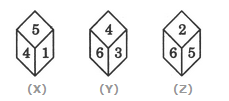 Correct
Correct
From positions X and Y we conclude that 1, 5, 6 and 3 lie adjacent to 4. Therefore, 2 must lie opposite 4. From positions Y and Z we conclude that 4, 3, 2 and 5 lie adjacent to 6. Therefore, 1 must lie opposite 6. Thus, 2 lies opposite 4, 1 lies opposite 6 and consequently 5 lies opposite 3.
As analysed above, the number opposite 6 is 1 and the number opposite 5 is 3. Therefore, the numbers hidden behind the numbers 6 and 5 in position Z (these are the numbers opposite 5 and 6 respectively) are 1 and 3.
Incorrect
From positions X and Y we conclude that 1, 5, 6 and 3 lie adjacent to 4. Therefore, 2 must lie opposite 4. From positions Y and Z we conclude that 4, 3, 2 and 5 lie adjacent to 6. Therefore, 1 must lie opposite 6. Thus, 2 lies opposite 4, 1 lies opposite 6 and consequently 5 lies opposite 3.
As analysed above, the number opposite 6 is 1 and the number opposite 5 is 3. Therefore, the numbers hidden behind the numbers 6 and 5 in position Z (these are the numbers opposite 5 and 6 respectively) are 1 and 3.
-
Question 20 of 30
20. Question
1 pointsFour positions of a dice are shown below. What number must be at the bottom face when the dice is in the position as shown in the figure(iii)
 Correct
Correct
From figures (i), (ii), (iv) we conclude that 5, 6, 1 and 2 lie adjacent to 4. Hence, 3 must lie opposite 4 and vice-versa. In fig. (iii), 3 is at the top and consequently 4 must lie at the bottom face.
Incorrect
From figures (i), (ii), (iv) we conclude that 5, 6, 1 and 2 lie adjacent to 4. Hence, 3 must lie opposite 4 and vice-versa. In fig. (iii), 3 is at the top and consequently 4 must lie at the bottom face.
-
Question 21 of 30
21. Question
1 pointsThree different positions X, Y and Z of a dice are shown in the figures given below. Which number lies at the bottom face in position Y?
 Correct
Correct
From positions X and Y we conclude that 1, 5, 6 and 3 lie adjacent to 4. Therefore, 2 must lie opposite 4. From positions Y and Z we conclude that 4, 3, 2 and 5 lie adjacent to 6. Therefore, 1 must lie opposite 6. Thus, 2 lies opposite 4, 1 lies opposite 6 and consequently 5 lies opposite 3.
As analysed above, the number on the face opposite 4 is 2. In position Y, since 4 lies on the top, therefore 2 must lie at the bottom face.
Incorrect
From positions X and Y we conclude that 1, 5, 6 and 3 lie adjacent to 4. Therefore, 2 must lie opposite 4. From positions Y and Z we conclude that 4, 3, 2 and 5 lie adjacent to 6. Therefore, 1 must lie opposite 6. Thus, 2 lies opposite 4, 1 lies opposite 6 and consequently 5 lies opposite 3.
As analysed above, the number on the face opposite 4 is 2. In position Y, since 4 lies on the top, therefore 2 must lie at the bottom face.
-
Question 22 of 30
22. Question
1 pointsWhat is the opposite 3, if four different positions of dice are as shown below?
 Correct
Correct
From figures (i), (iii) and (iv), we conclude that 2, 6, 1. and 5 appear adjacent to 3. Clearly, 4 will appear opposite 3.
Incorrect
From figures (i), (iii) and (iv), we conclude that 2, 6, 1. and 5 appear adjacent to 3. Clearly, 4 will appear opposite 3.
-
Question 23 of 30
23. Question
1 pointsThe four different positions of dice are given below: Which number is on the face opposite 6?
 Correct
Correct
From figures (i), (ii) and (iii), we conclude that the numbers 2, 3, 4 and 5 appear adjacent to 6.
Clearly, the remaining number i.e. 1 will appear on the face opposite 6.
Incorrect
From figures (i), (ii) and (iii), we conclude that the numbers 2, 3, 4 and 5 appear adjacent to 6.
Clearly, the remaining number i.e. 1 will appear on the face opposite 6.
-
Question 24 of 30
24. Question
1 pointsA dice is numbered from 1 to 6 in different ways
If 1 is opposite to 2 and adjacent to 3 and 4, then which of the following statements is necessarily true?Correct
If 1 is opposite to 2, then 2 cannot lie opposite to any of the numbers 3, 4, 5 or 6. Hence, 2 necessarily lies adjacent to 6.
Incorrect
If 1 is opposite to 2, then 2 cannot lie opposite to any of the numbers 3, 4, 5 or 6. Hence, 2 necessarily lies adjacent to 6.
-
Question 25 of 30
25. Question
1 pointsThree different positions X, Y and Z of a dice are shown in the figures given below. Which number lies opposite 6?
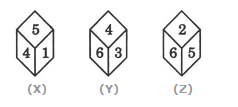 Correct
Correct
From positions X and Y we conclude that 1, 5, 6 and 3 lie adjacent to 4. Therefore, 2 must lie opposite 4. From positions Y and Z we conclude that 4, 3, 2 and 5 lie adjacent to 6. Therefore, 1 must lie opposite 6. Thus, 2 lies opposite 4, 1 lies opposite 6 and consequently 5 lies opposite 3.
As analysed above, 1 lies opposite 6.
Incorrect
From positions X and Y we conclude that 1, 5, 6 and 3 lie adjacent to 4. Therefore, 2 must lie opposite 4. From positions Y and Z we conclude that 4, 3, 2 and 5 lie adjacent to 6. Therefore, 1 must lie opposite 6. Thus, 2 lies opposite 4, 1 lies opposite 6 and consequently 5 lies opposite 3.
As analysed above, 1 lies opposite 6.
-
Question 26 of 30
26. Question
1 pointsThree different positions X, Y and Z of a dice are shown in the figures given below. Which number lies at the bottom face in position X?
 Correct
Correct
From positions X and Y we conclude that 1, 5, 6 and 3 lie adjacent to 4. Therefore, 2 must lie opposite 4. From positions Y and Z we conclude that 4, 3, 2 and 5 lie adjacent to 6. Therefore, 1 must lie opposite 6. Thus, 2 lies opposite 4, 1 lies opposite 6 and consequently 5 lies opposite 3.
As analysed above, the number on the face opposite 5 is 3. In position X, since 5 lies on the top, therefore 3 must lie at the bottom face.
Incorrect
From positions X and Y we conclude that 1, 5, 6 and 3 lie adjacent to 4. Therefore, 2 must lie opposite 4. From positions Y and Z we conclude that 4, 3, 2 and 5 lie adjacent to 6. Therefore, 1 must lie opposite 6. Thus, 2 lies opposite 4, 1 lies opposite 6 and consequently 5 lies opposite 3.
As analysed above, the number on the face opposite 5 is 3. In position X, since 5 lies on the top, therefore 3 must lie at the bottom face.
-
Question 27 of 30
27. Question
1 pointsIf the total number of dots on opposite faces of a cubical block is always 7, find the figure which is correct.
 Correct
Correct
Since the total number of dots on opposite faces is always 7, therefore, 1 dot appears opposite 6 dots, 2 dots appear opposite 5 dots and 3 dots appear opposite 4 dots.
Incorrect
Since the total number of dots on opposite faces is always 7, therefore, 1 dot appears opposite 6 dots, 2 dots appear opposite 5 dots and 3 dots appear opposite 4 dots.
-
Question 28 of 30
28. Question
1 pointsTwo positions of a block are given below. When 1 is at the top, which number will be at the bottom?
 Correct
Correct
Number 2 is common to the two positions of the dice. We assume the dice in fig. (ii) to be rotated so that 2 remains on the top face (i.e. face V as per activity 1) and the numbers 3 and 6 move to the faces hidden behind 5 and 1 respectively [in fig. (i)]. Then, clearly, 5 lies opposite 3 and 6 lies opposite 1. Hence, when 1 is at the top, then 6 will be at the bottom.
Incorrect
Number 2 is common to the two positions of the dice. We assume the dice in fig. (ii) to be rotated so that 2 remains on the top face (i.e. face V as per activity 1) and the numbers 3 and 6 move to the faces hidden behind 5 and 1 respectively [in fig. (i)]. Then, clearly, 5 lies opposite 3 and 6 lies opposite 1. Hence, when 1 is at the top, then 6 will be at the bottom.
-
Question 29 of 30
29. Question
1 pointsWhat number is opposite 3 in the figure shown below? The given two positions are of the same dice whose each surface bears a number among 1, 2, 3, 4, 5 and 6.
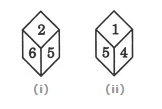 Correct
Correct
From figures (i) and (ii), we conclude that 2, 6, 1 and 4 appear adjacent to 5. Therefore, 3 must appear opposite 5, Conversely, the number opposite 3 is 5.
Incorrect
From figures (i) and (ii), we conclude that 2, 6, 1 and 4 appear adjacent to 5. Therefore, 3 must appear opposite 5, Conversely, the number opposite 3 is 5.
-
Question 30 of 30
30. Question
1 pointsTwo positions of a dice are shown below. Identify the number at the bottom when the top is '3'?
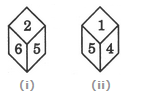 Correct
Correct
The number 6 is common to both the positions of the dice. We assume the dice in fig. (ii) to be rotated so that 6 remains on the FR-LH face (i. e. on face IV as per activity 1) and the numbers 1 and 3 move to the faces hidden behind 4 and 5 respectively [in fig. (i)]. Then, 5 lies on FR-RH face (i.e. face I), 4 lies on Top face {i.e. face V), 3 lies on RR-LH face (i.e. face III) and 1 lies on Bottom face (i.e. face VI). Thus, 3 lies opposite 5. Hence, when the top is 3, then the number at the bottom is 5.
Incorrect
The number 6 is common to both the positions of the dice. We assume the dice in fig. (ii) to be rotated so that 6 remains on the FR-LH face (i. e. on face IV as per activity 1) and the numbers 1 and 3 move to the faces hidden behind 4 and 5 respectively [in fig. (i)]. Then, 5 lies on FR-RH face (i.e. face I), 4 lies on Top face {i.e. face V), 3 lies on RR-LH face (i.e. face III) and 1 lies on Bottom face (i.e. face VI). Thus, 3 lies opposite 5. Hence, when the top is 3, then the number at the bottom is 5.
Cubes and Dice Video Lecture

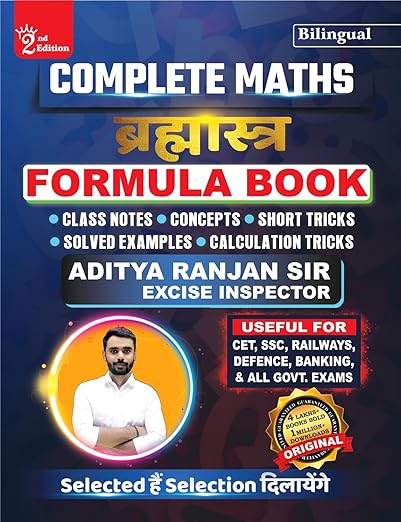
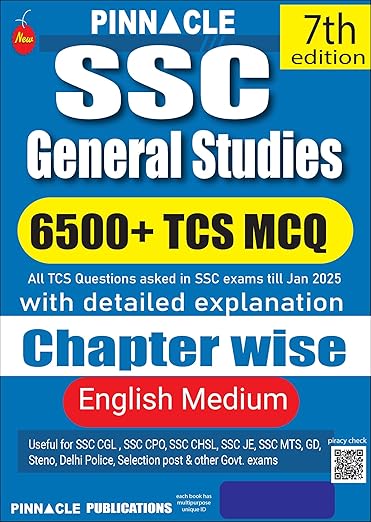
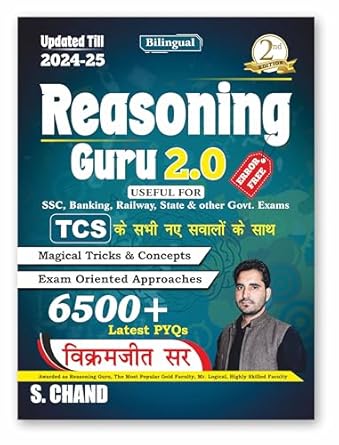
0 Comments